Each year, around 1000 polar bears migrate to the town of Churchill in Manitoba, earning it the moniker of the ‘polar bear capital of the world’. This annual migration attracts thousands of visitors who are keen to see the polar bears in their natural environment but few realise that Manitoba is also home to other treasures. There are hidden gems in every corner of the province, from historical sites left as a legacy from the province’s wild fur trading days to contemporary landmarks celebrating the province’s rich cultural tapestry.
From the uber-contemporary Canadian Museum of Human Rights to the quirky mining town of Flin Flon, named after a cartoon character; from 1500-year-old petroforms in Whiteshell Provincial Park to the boreal forest of Pimachiowin Aki to the sign marking the centre of Canada, these historical, natural and quirky landmarks in Manitoba will give you plenty of reasons to visit.
20 Incredible Landmarks in Manitoba
Manmade Landmarks
1- Canadian Museum For Human Rights
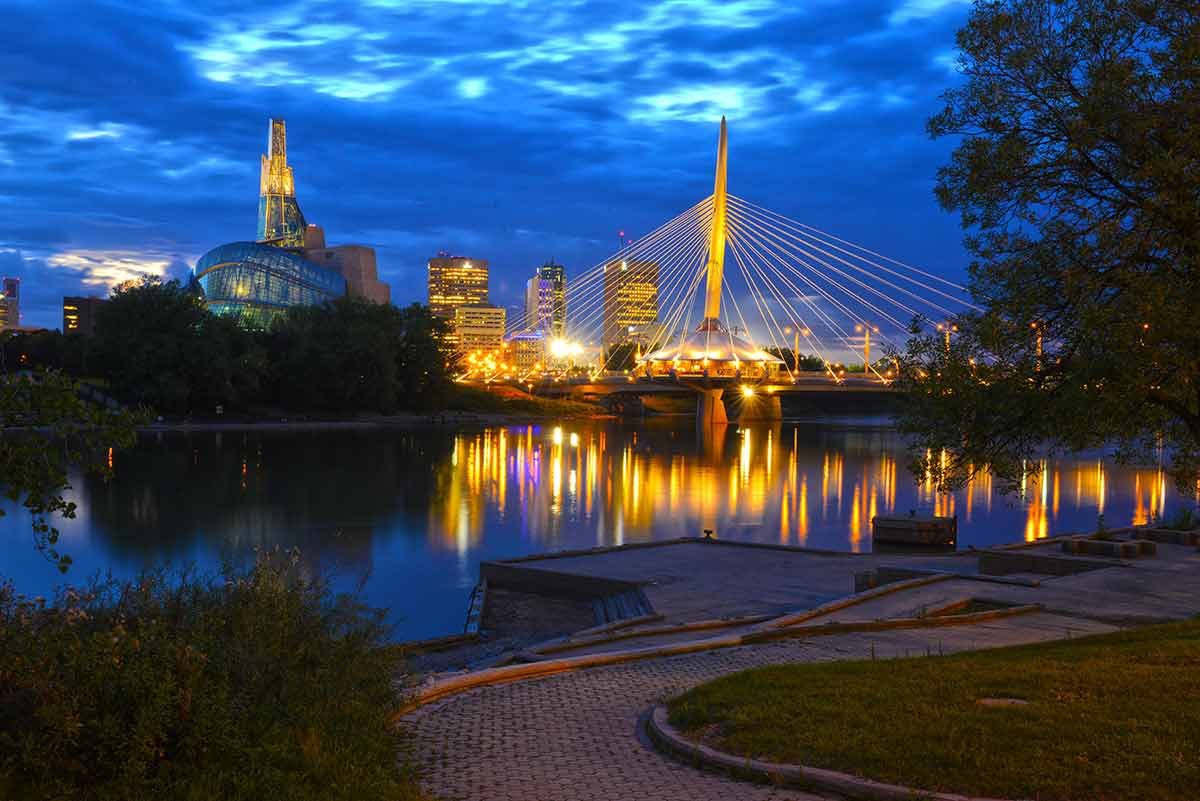
The Canadian Museum For Human Rights is a 21st-century architectural marvel and a Canadian landmark that makes a design statement with bold geometric curves, irregular surfaces and walls that slope at odd angles. The gleaming glass and steel monument has 1669 pieces of cut glass and one kilometre of alabaster-clad ramps. Supported by 5,400 tonnes of steel framework, glass panels in ‘The Cloud’ contain argon gas for insulation.
The CMHR is a unique 21st-century temple that thoroughly explores human rights through innovative displays, exhibitions and events. The building, which stands on the ancestral lands of the First Nations and the Métis, is a bridge between the past, present and future.
The museum’s management is committed to protecting the environment. Several measures are in place such as sourcing water from the Shoal Lake 40 First Nation as well as harvesting rainwater for air conditioning and toilet flushing. It has 2800 sqm of roof seeded with prairie grass and indigenous Manitoba plants.
The Canadian Museum For Human Rights opened on 20 September 2014 and is at 85 Israel Asper Way, Winnipeg, Manitoba.
2- Qaumajuq
Winnipeg’s uber-contemporary Qaumajuq (pronounced kow-ma-yourk) is an architectural landmark built as an addition to the Winnipeg Art Gallery. Home to Manitoba’s Inuit art centre, Qaumajuq means ‘it is bright, it is lit’ and its name along with the names of its various spaces were decided by Indigenous language keepers and elders in a virtual gathering.
The building’s contemporary architecture is eye-catching, with an undulating white Bethel granite façade hovering above the glass lobby. The Visible Vault in the entrance hall is a massive three-storey curved glass vault with thousands of carvings on display and a live showcase of curators and conservators at work.
The centre brings Inuit art and culture to Winnipeg through exhibitions, research, education and art. The collection of 14,000 carvings, drawings, prints, textiles, and new media is the world’s most extensive public collection of Inuit art.
The collection is more than just a beautiful display of carvings and drawings. The museum shares the stories that these pieces tell, which makes it easier for visitors to understand how they relate together as part of an intricate culture with deep meaning behind each piece.
The displays provide engaging ways to experience art and connect to the lands, peoples and cultures of the North. It’s also a space for Inuit elders to pass their teachings to the broader community and future generations.
Qaumajuq is in the Winnipeg Art Gallery at 300 Memorial Blvd, Winnipeg, Manitoba.
3- St Boniface Cathedral
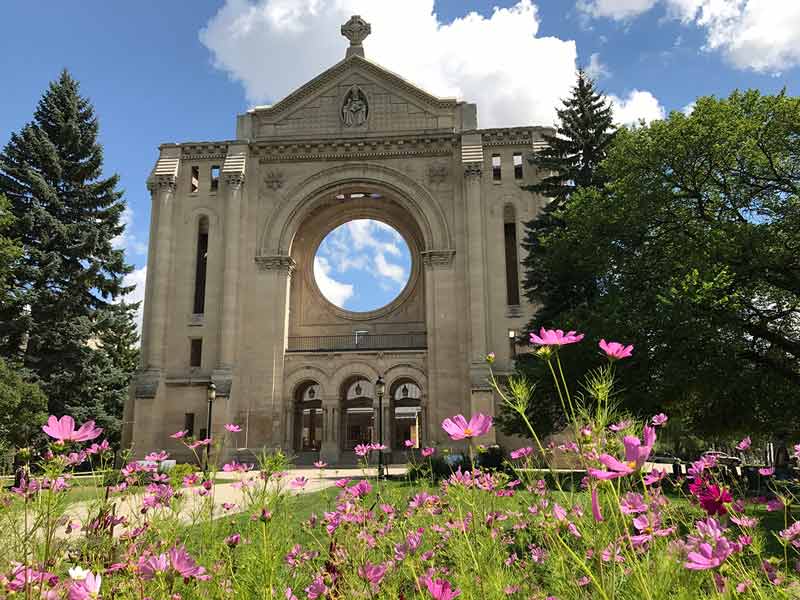
The 1908 facade of St Boniface Cathedral is a historic landmark of Manitoba’s French culture. The latest cathedral was build in 1972 and still operates today, making the monument a fusion of old and new buildings.
The cemetery is the resting place of historical figures who played key roles in the province’s development, such as Louis Riel. The St. Boniface Cathedral Cemetery guided tour offers a theatrical experience that brings history to life.
Before merging with Winnipeg in 1972, St Boniface was a city with the largest francophone community in Western Canada. Walk across the Esplanade Riel Pedestrian Bridge from The Forks and hang out in cool cafes, listen to live music, buy French books and eat beef bourguignon and coq au vin at St Boniface.
Saint Boniface Cathedral is at 180 Avenue de la Cathedrale, Winnipeg.
4- Assiniboine Park Pavilion
Assiniboine Park Pavilion is a lesser-known landmark in Assiniboine Park, home to the well-known Assiniboine Park Zoo, English Garden and Leo Mol Sculpture Garden. It’s worth visiting, especially for its Winnie-the-Pooh gallery.
Did you know that the black bear that inspired A. A. Milne’s famous character Winnie-the-Pooh was named after Winnipeg? Canadian Lieutenant Harry Colebourn took a bear cub to England at the start of World War I and left the cub at London Zoo when his unit went to France.
The Pavilion’s original building dates back to 1908 and was rebuilt after a fire in 1930. It houses the largest collections of works by famous Manitoba artists Ivan Eyre, Walter J. Phillips, and Clarence Tillenius.
Assiniboine Park & Zoo is at 55 Pavilion Crescent, Winnipeg.
5- Churchill’s Polar Bear ‘jail’
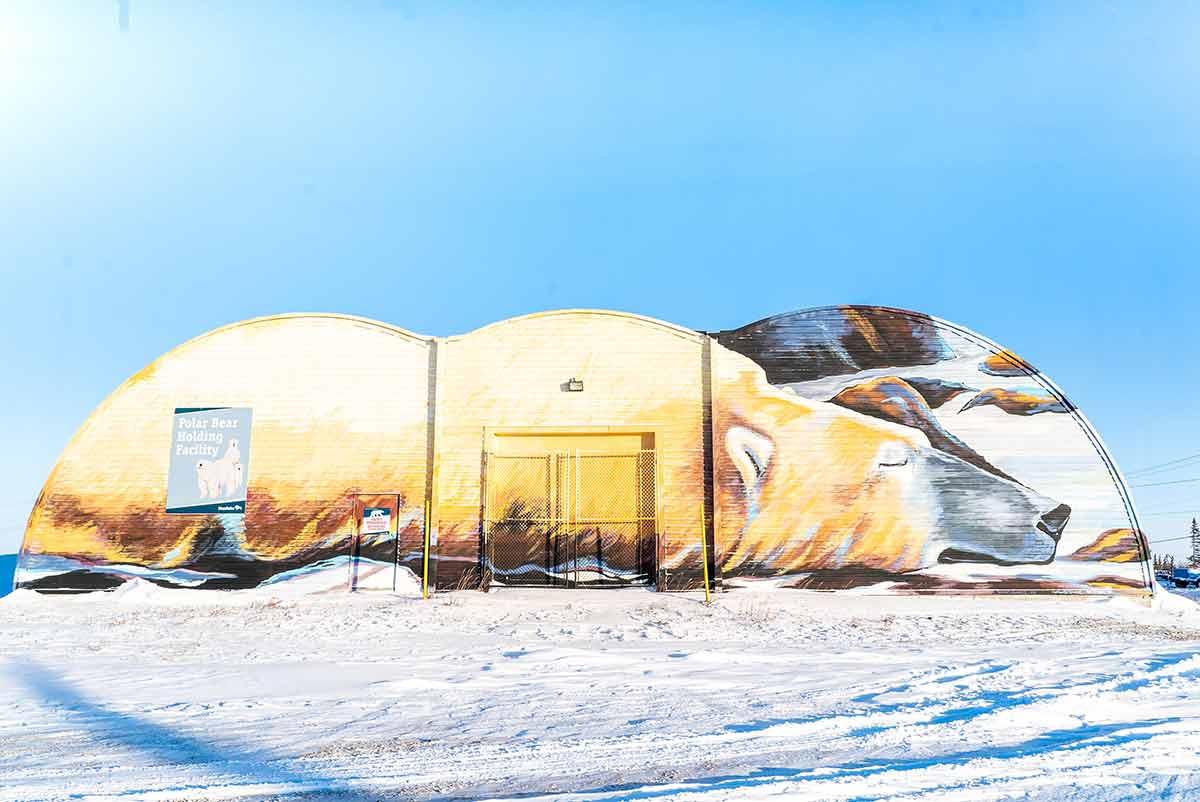
Churchill has earned the title of polar bear capital of the world because polar bears gather in the area each year while waiting for the sea ice to return. There are around 1,000 polar bears around the Churchill area, attracting tourists, scientists and photographers who flock to see, study and photograph polar bears in their natural environment along the shore of Hudson Bay.
In winter, polar bears hunt for food on sea ice, but global warming has forced them to spend more time on land because the Arctic waters are freezing later and thawing earlier.
This cycle has increased the number of encounters between polar bears and people in Churchill, as sometimes bears get too comfortable around town. As a result, bears that keep venturing into town are tranquilised and held in the Polar Bear Holding Facility or polar bear ‘jail’ and stubborn individuals are sometimes relocated back into the wilderness by helicopter.
The Polar Bear Holding Facility is in a former aircraft hangar near the airport and visitors are not allowed inside. However, Churchill is also home to Polar Bears International, an organisation dedicated to the conservation of polar bears. You can see polar bears by Tundra Buggy or on a walking tour while staying at a lodge or by boat or helicopter.
6- Immaculate Conception Church
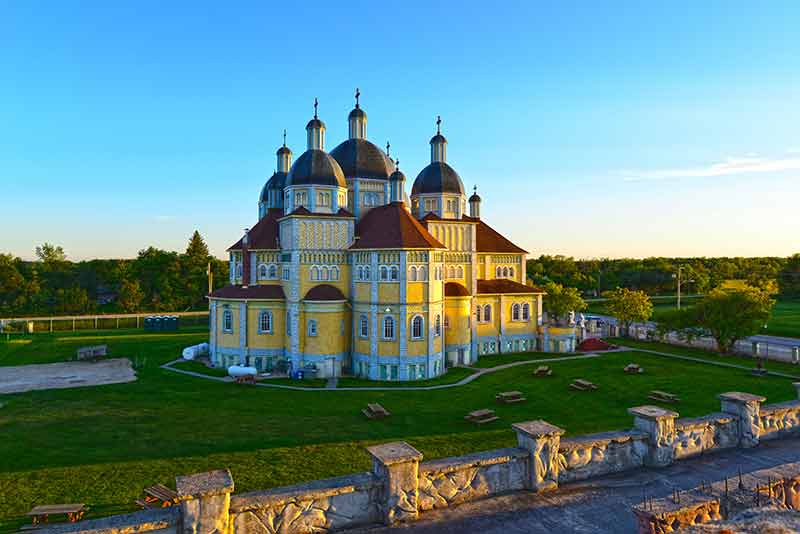
The multi-domed Immaculate Conception Church is a grand Ukrainian church that is an unexpected sight in Manitoba. The impressive Prairie cathedral-style church was built by volunteers between 1930 and 1951 from concrete, stucco and painted with Ukrainian motifs.
The complex includes a grotto and cemetery and there’s a medieval festival in summer, with jousting, archery and food stalls.
The Ukrainian Catholic Church is a symbol of the Ukrainian community. The first settlers came to Cooks Creek during the mid-1860s, followed by a more significant influx in 1897 when Polish and Ukrainian migrants went to the western prairies to farm the land.
Immaculate Conception Church is at Cooks Creek Road, Hazelridge.
7- York Factory National Historic Site
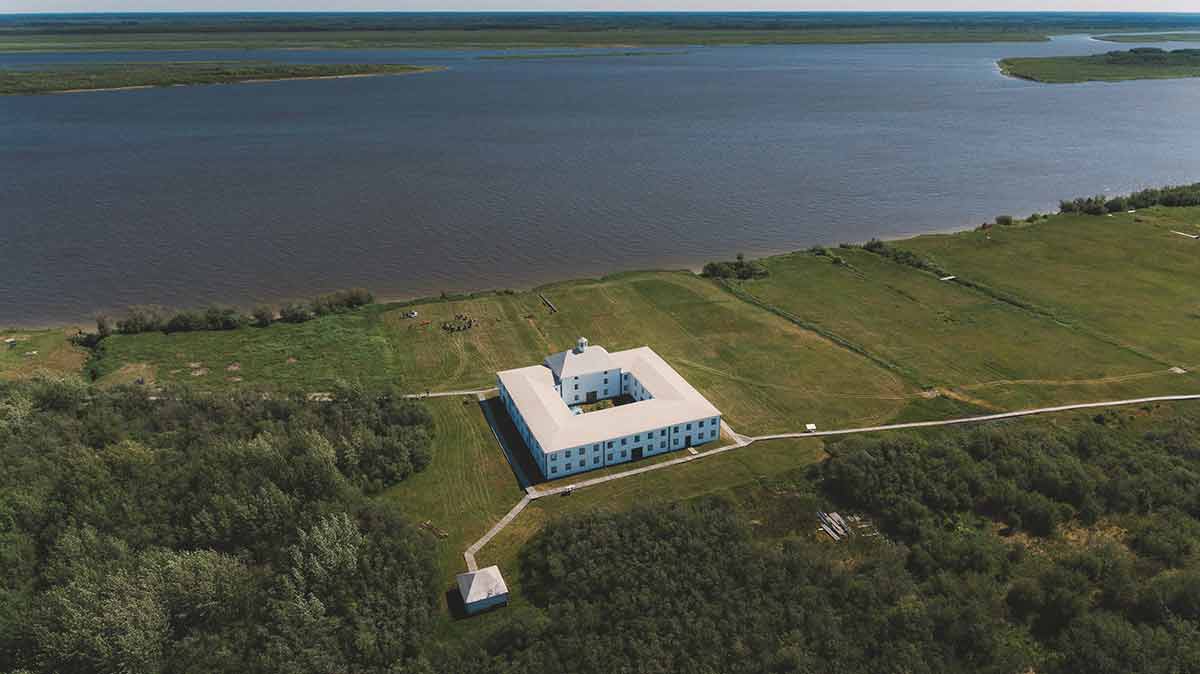
York Factory is a legacy of the fur trade and was a fur-trading post for the Hudson Bay Company for 273 years. The depot had a vibrant community of hundreds of inhabitants during its heyday, including a doctor, church, and cooperage. In addition, there was a Cree community not far away.
These days, only the cemetery, the ruins of a gunpowder magazine and the depot building remain. The depot was constructed in 1832 and is the oldest timber building still standing on permafrost, worth visiting for its history and archaeological artifacts recovered from the site.
The remote site in the subarctic wilderness can be reached by private boat or air charter and offers guided tours in July and August.
York Factory National Historic Site is in a remote location on the shore of the Hayes River near its confluence with Hudson Bay.
8- Gimli Viking Park
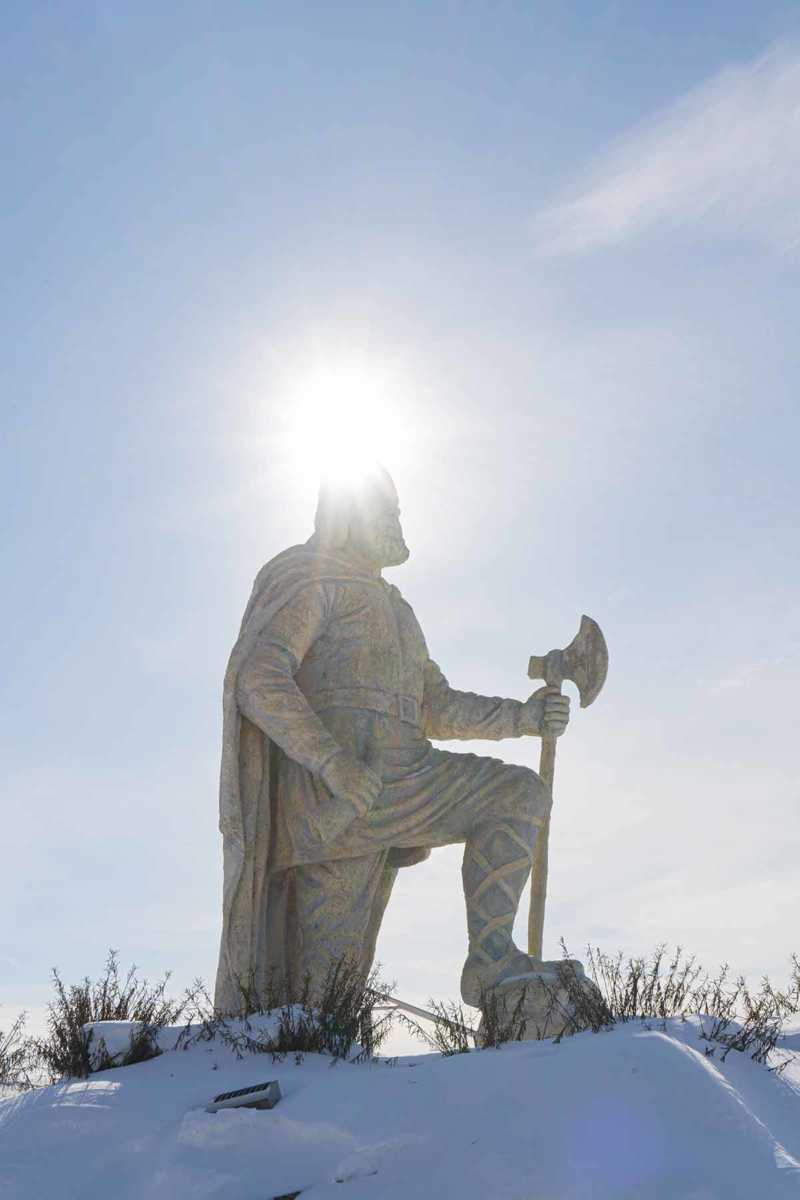
According to Norse mythology, Gimli is a beautiful place in the afterlife where only the worthy are allowed. Manitoba’s Gimli, however, is a popular place for its beaches in summer and ice fishing in winter.
It’s also famous for its massive Viking statue, erected in 1967 to mark Canada’s 100th anniversary. Gimli is also known as New Iceland because Viking heritage and Icelandic culture and attractions flavour the town, from tasting traditional vinatarta prune torte to seeing displays at the New Iceland Heritage Museum to going Nordic skiing.
Gimli Viking Park tells Norse mythology stories, with tiny houses for elves and troll faces carved into stones. The heritage wall documents the community’s history and includes a key to solving the rune puzzles carved into the stone pathway.
Icelanders emigrated to Canada in the early 1870s to look for greener pastures and escape from cities ravaged by volcanic eruptions. As a result, Canada has the largest population of Icelandic descendants outside of Iceland. One-third of Canada’s Icelandic population calls Gimli home.
Gimli Viking Park is at 104 2 Ave, Gimli and is 89 km from Winnipeg.
9- Thompson Wolf Mural
Manitoba is home to around 5000 grey wolves that hunt for elk, moose, caribou and deer in the province’s boreal forests. Wolves are shy and are not easy to spot, but Thompson has a wolf landmark you can’t miss.
The massive Bateman Wolf Mural is a 10-storey photo reproduction of wildlife painter Robert Bateman’s Wolf Sketch. The wolf landmark is the most noticeable along the Spirit Way Millennium Trail, a two-kilometre biking and walking pathway lined with 56 painted wolf statues and other points highlighting the area’s art, geology, heritage, culture, and scenery.
Canada has the largest population of grey wolves globally (about 50,000). Thompson hosted two International Wolf & Carnivore Conferences in 2012 and 2017. In 2017, the city broke the Guinness World Record for the most number of people howling like a wolf when 2,033 people participated in the group howl.
Thompson is in northern Manitoba, 761 km (473 miles) north of Winnipeg. The Bateman Wolf Mural is on the side of the Highland Tower building.
10- Centre of Canada Sign
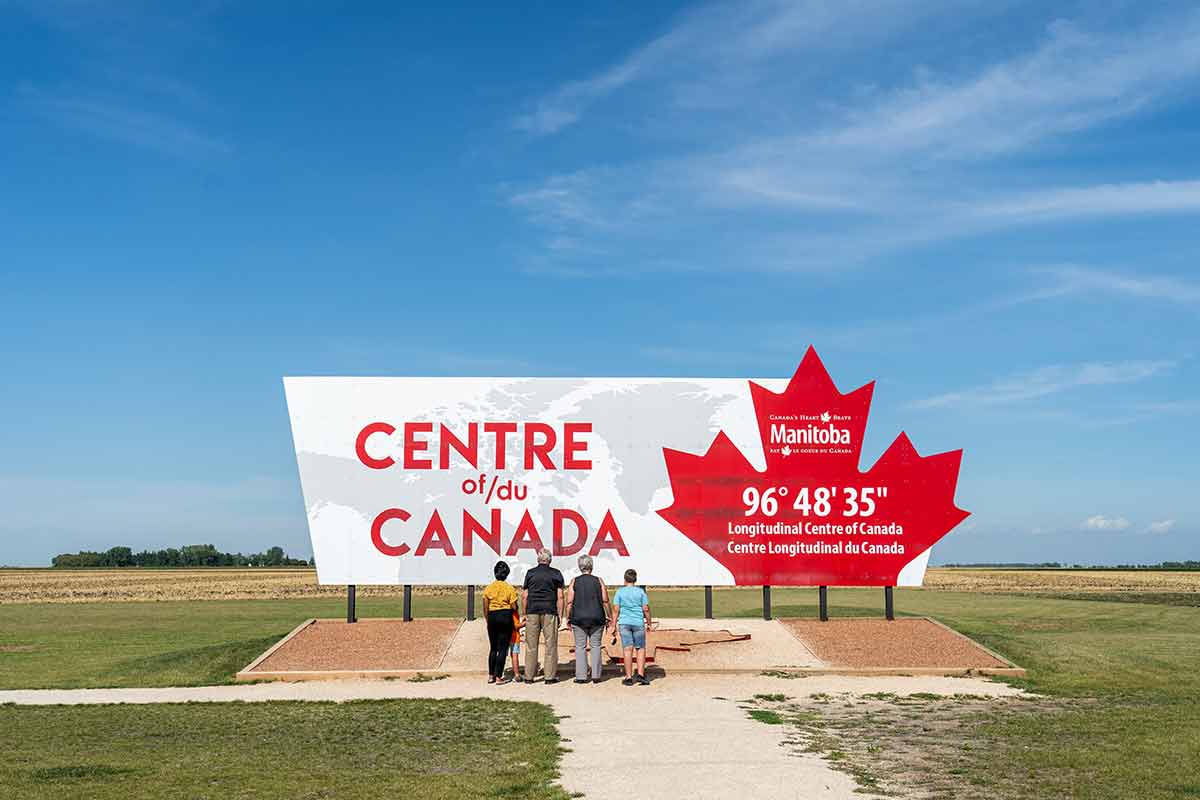
The sign marks the longitudinal centre of Canada and is a unique landmark in Manitoba on the Trans-Canada Highway.
The exact coordinates are 96° 48′ 35″ on the road sign and the spot is the centre of Canada based on the distance from its farthest outlying islands on either side.
The Centre of Canada is at 99 Trans-Canada Hwy, 15 km east of Winnipeg’s city limits near the town of Landmark.
11- Inukshuk in Churchill
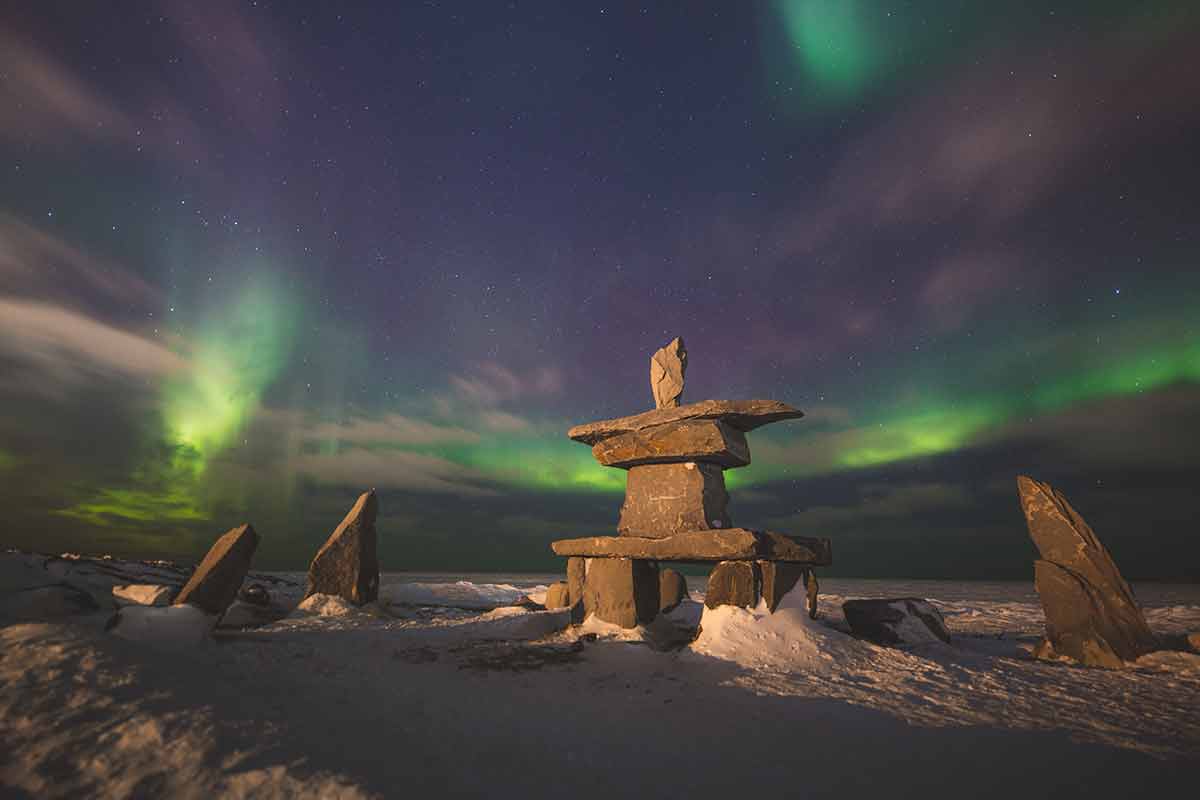
Inukshuks are Inuit landmarks used as navigational aids, coordination points, message centres and places to respect loved ones throughout the Arctic. Hunters used them to mark migration paths or fishing locations by the river.
‘Inukshuk’ means ‘in the likeness of a human’ and constructed from stones placed roughly to resemble the human form. They are inconsistent in size and built using whatever stones are available. The arrangement of stones signals the reason for the marker.
The Inukshuk on the beach in Churchill is one of the most popular places to photograph the Northern Lights.
Natural Landmarks in Manitoba
12- Northern Lights
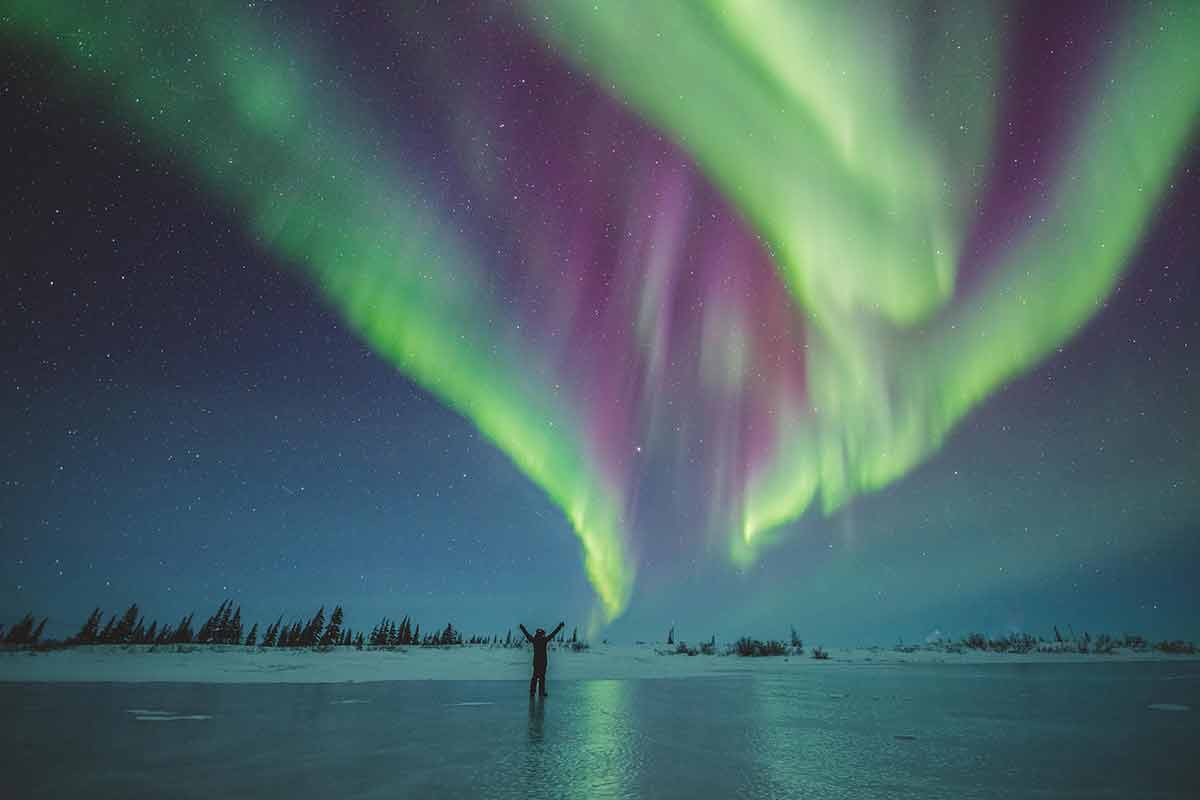
The Aurora Borealis is a mark of nature that can appear in the sky and be seen anywhere in Manitoba, but one of the best places to see Northern Lights is in Churchill, where the lights appear almost 300 nights a year.
According to Inuit mythology, the Northern Lights are the spirits of their ancestors playing ball with a walrus skull. The more scientific explanation is that the aurora borealis is caused by geomagnetic storms that cause the sun’s solar wind to move towards the earth. The magnetic field that protects the planet causes atoms and molecules to collide in the atmosphere to form protons that make up the aurora.
Although the Northern Lights is visible all year round, February and March are the best months because the skies are clear and the cloud cover isn’t a hindrance during the colder months.
13- Pisew Falls
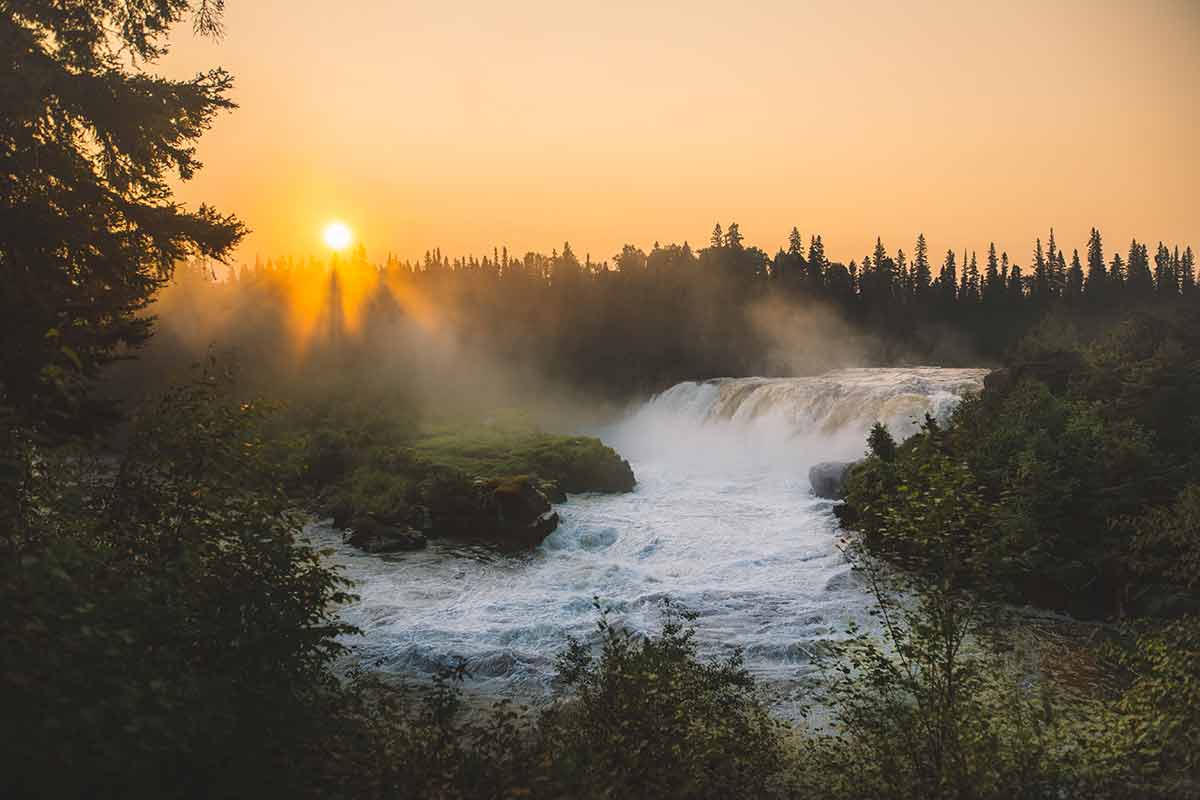
Pisew Falls is a waterfall where the Grass River drops 13 m (43 ft), changes direction and gushes down through a gorge. There are two boardwalks with views of the falls, but keen hikers should step up to the challenge of the multi-day, 30 km round trip hike to Kwasitchewan Falls and back.
The Upper Track Trail follows the Grass River and was the main waterway during the fur trade in the late 1700s. First Nations trackers showed traders from the Hudson Bay Trading Company how to follow the Upper Track to reach western Canada’s interior. The Woodland Cree used this track for thousands of years.
Pisew Falls is in Pisew Falls Provincial Park on the Grass River. It’s 73 km from Thompson.
14- Little Limestone Lake
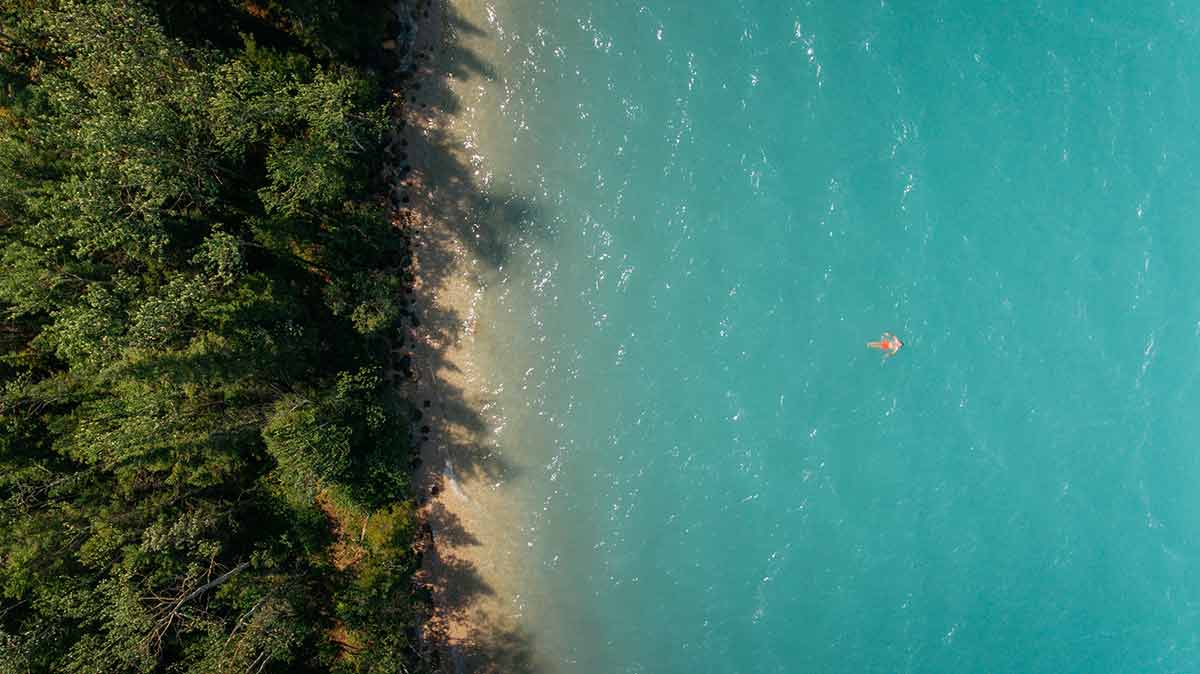
Little Limestone Lake is a 15 km-long lake that is one of the biggest marl lakes in the world.
Marl occurs when the limestone bedrock beneath the lake erodes and calcium carbonate is released into the water, forming the tiny white marl crystals. The quantity of marl increases as the temperature of the water rises during the day, causing a stunning colour transformation. This phenomenon causes the colour of the lake to change dramatically, from brilliant turquoise in the morning to a milky blue to white later in the day.
The area is home to threatened woodland caribou and other wildlife like lynx, foxes, muskrat and moose. Fortunately, the lake’s eastern shore borders Mosakahiken Cree Nation territory and the Manitoba government has an agreement to cooperatively manage the park’s resources by focusing on balancing ecotourism and preservation. However, as the lake’s ecosystem is fragile, roads, trails and buildings are not allowed.
Little Limestone Lake is in Little Limestone Lake Provincial Park in northern Manitoba, about 500 km north of Winnipeg. The nearest town is Grand Rapids, which is 65 km away.
15- Bannock Point Petroforms
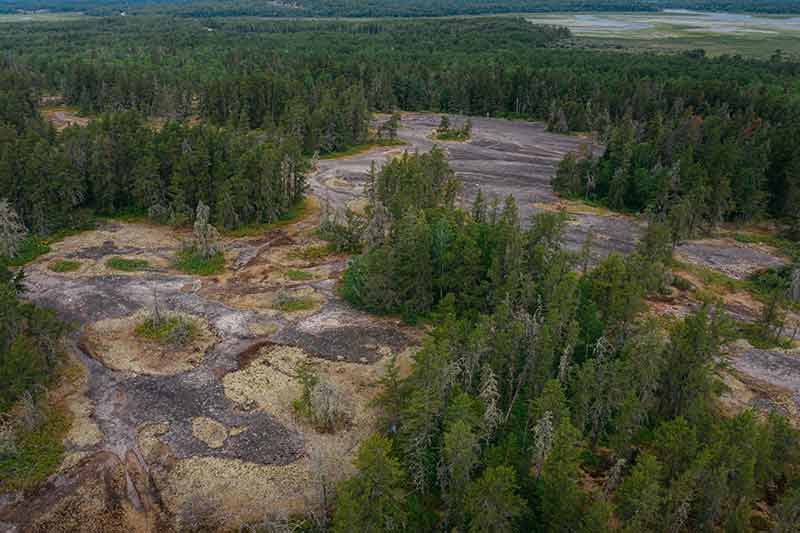
Bannock Point Petroforms are ancient rock art created with stones or small boulders arranged on bedrock outcrops in the shape of turtles, snakes and other geometric designs.
The purpose of the rocks that date back to AD500 is still a mystery, however, the First Nations people use these rocks for healing and learning. The Anishinaabe people consider the petroforms as sacred and pay homage by leaving gifts of fabric and tobacco.
Bannock Point Petroforms are in Whiteshell Provincial Park, 140 km from Winnipeg, and must be visited with a First Nations guide.
16- Narcisse Snake Dens

The Narcisse Snake Dens is a provincial wildlife management area home to tens of thousands of red-sided garter snakes. The dens writhe with red-sided garter snakes in spring as they slither from their winter den for the annual mating ritual.
The ritual is spectacular but short, usually between one and three weeks. The window to visit is in late May and can be unpredictable.
A 3 km self-guiding interpretive trail connects four active snake dens, where the mating rituals of the snakes are fascinating. In early spring, up to 100 male snakes lie in wait for females in a mating ball.
Narcisse Snake Dens is off Highway 17, six kilometres north of Narcisse.
17- Bruce the Mosasaur at Canadian Fossil Discovery Centre
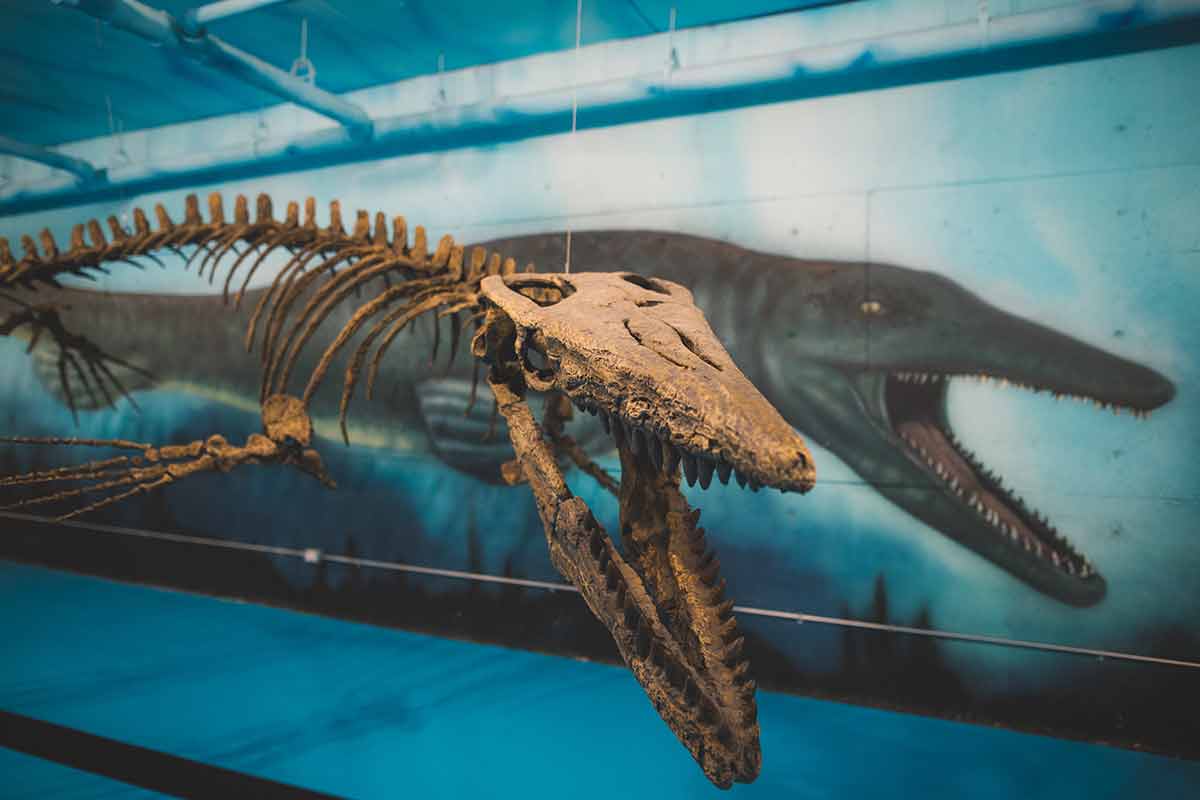
Bruce the mosasaur holds the Guinness World Record as the largest publicly displayed mosasaur in the world. The tylosaurus pembinensis measures more than 13 m (approximately 43 feet) long and is an impressive Canadian Fossil Discovery Centre feature.
The centre is also home to Canada’s most extensive collection of marine reptile fossils and has many treasures on display from the late Cretaceous period.
The centre runs educational programmes and the opportunity to join their crew on a real fossil dig.
Bruce is in the Canadian Fossil Discovery Centre, 126 km south of Winnipeg, at 111 Gilmour St B, Morden.
18- Pimachiowin Aki
Pimachiowin Aki, which means ‘The Land That Gives Life’ in the Anishinaabemowin language, is a UNESCO World Heritage Site straddling Manitoba and Ontario.
It’s a living cultural landscape with over 3200 lakes, 5000 freshwater marshes and 32,000 km of shoreline wetlands. Pimachiowin Aki is a wonderous natural landscape home to an abundance of wildlife, fish, birds and plants, including at least 10 bird species at risk. It has three herds of threatened woodland caribou, including one of Manitoba’s largest herds.
Pimachiowin Aki is the only mixed site of Canada’s UNESCO World Heritage sites recognised for its cultural and natural values and Manitoba’s first on the World Heritage list.
The 2.9 ha Pimachiowin Aki has North America’s largest protected area of boreal shield, which is an ecosystem where boreal forest and Canadian Shield overlap.
19- Centennial River Skating Trail
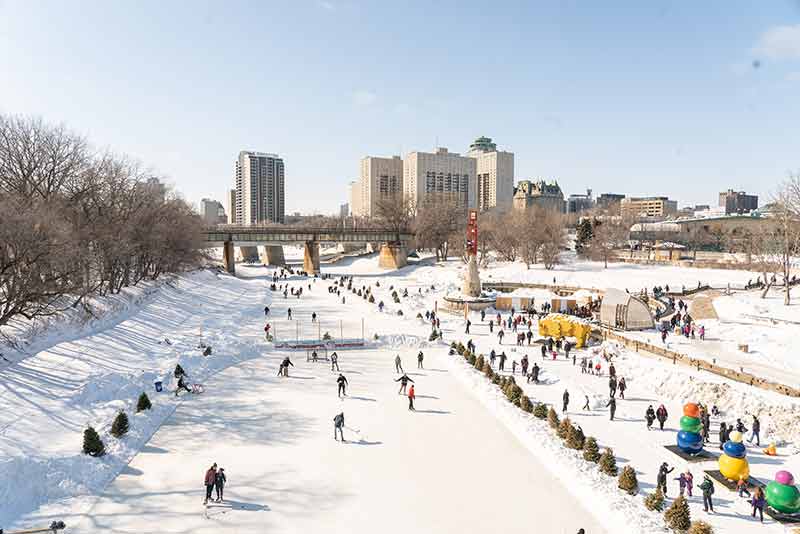
The Centennial River Trail is a natural landmark in Manitoba on the Assiniboine and Red Rivers, built upon a moving body of water. The opening and closing dates of the trail are entirely dependent on the weather and conditions of the ice. In the past, the trail has opened in January and usually closes in March.
How far the Centennial River Trail extends each year depends on weather conditions and how the river freezes. The trail is groomed daily and free for everyone to use.
Warming huts are built on the trail, usually around the third week of January but is also weather dependent. Find out more here.
20- Flin Flon
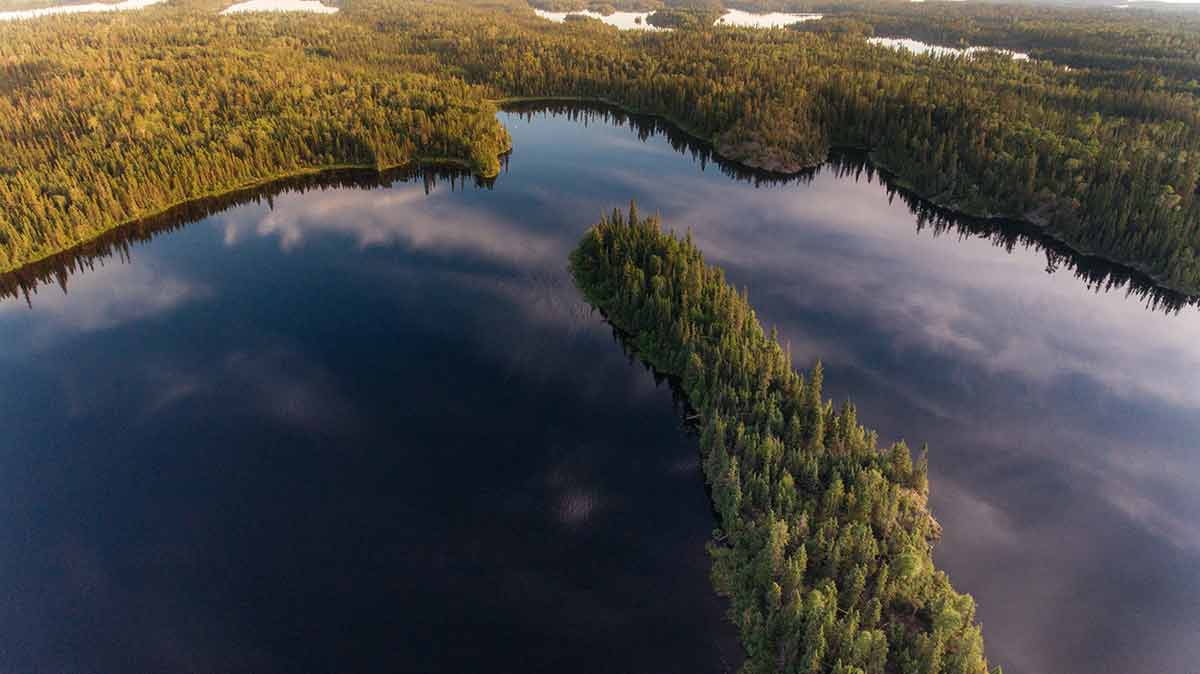
Flin Flon is a mining city that sits on the Manitoba/Saskatchewan border and is known as the ‘city built on rock’ because most of Flin Flon’s surface consists of exposed Canadian Shield bedrock.
Due to its rocky ground and climate, agriculture is generally not viable. The Flin Flon Belt is a Precambrian volcanic belt formed 1.9 billion years ago by aquatic volcanic eruptions that, along with multiple episodes of glaciation, moulded the unique landscape seen today. This belt produces the area’s vast mineral deposits, primarily zinc, copper, silver and gold.
The extensive bedrock exposure has forced the residents to be creative. For example, in the northwestern areas of the city, sewer boxes are placed above the surface as it’s not possible to bury water and sewer lines.
Named after Josiah Flintabbatey Flonatin, the hero of the science fiction novel ‘The Sunless City’, Flin Flon has a population of just over 5,000 and was established initially to mine the area’s copper and zinc ore.
A quirky statue of the professor, designed by American cartoonist Al Capp, stands on the city’s outskirts.
Also read:
- 20 USA Landmarks
- 23 Canada Landmarks
- 22 Ohio Landmarks
- 21 Arizona Landmarks
- 21 Minnesota Landmarks
- 21 Oregon Landmarks
- 21 Illinois Landmarks
- 21 Colorado Landmarks
- 21 Georgia Landmarks
- 21 Michigan Landmarks
- 23 Los Angeles Landmarks
- 21 Washington Landmarks
- 21 Maryland Landmarks
- 20 Manitoba Landmarks
- 20 Kansas Landmarks
- 21 New Mexico Landmarks
- 20 Idaho Landmarks
- 20 Montana Landmarks
- 20 Oklahoma Landmarks
- 21 Wisconsin Landmarks
- 20 Tennessee Landmarks
- 21 Iowa Landmarks
- 20 Alaska Landmarks
- 20 Miami Landmarks
- 21 West Virginia Landmarks
- 21 Kentucky Landmarks
- 20 Louisiana Landmarks
- 21 Arkansas Landmarks
- 20 Cincinnati Landmarks
- 20 San Antonio Landmarks
- 25 Indiana Landmarks
- 21 New York Landmarks
- 20 Texas Landmarks
- 21 Boston Landmarks
- 20 Florida Landmarks
- 20 Hawaii Landmarks
- 5 South Dakota Landmarks
- 21 Pennsylvania Landmarks
- 23 New Jersey Landmarks
- 21 Virginia Landmarks
- 21 North Carolina Landmarks
- 21 Utah Landmarks
- 21 Nevada Landmarks
- 20 Massachusetts Landmarks
- 20 Washington DC Landmarks
- 20 Vermont Landmarks
- 20 Nebraska Landmarks
- 20 North Dakota Landmarks
- 21 Missouri Landmarks
- 20 Rhode Island Landmarks
- 21 Maine Landmarks
- 21 Connecticut Landmarks
- 20 San Diego Landmarks
- 20 Landmarks In South Carolina
- 20 Mississippi Landmarks
- 20 Las Vegas Landmarks
- 20 Dallas Landmarks
- 20 Houston Landmarks
- 20 Seattle Landmarks
This post was published in partnership with Travel Manitoba.
Plan Your Trip

Rent A Car – Find the best car rental rates at Discover Cars. They compare car hire companies to provide you with the best deal right now.

Find A Hotel – If you’re curious about this article and are looking for somewhere to stay, take a look at these amazing hotels.





